Photography & Human Rights
By Liam Kennedy
Photography has long been integral to the articulation and understanding of human rights claims and has played a key role in promoting and sustaining a humanistic perspective on embodied suffering. This perspective predates the medium of photography, having philosophical and cultural roots in the modern humanistic tradition that advanced ideas of sympathy and compassion at the heart of the social bond. Humanitarian narratives of the eighteenth and nineteenth centuries relied “on the personal body, not only as he locus of pain but also as the common bond between those who suffer and those who would help” (Thomas Lacquer). With the advent of photography, documentary imagery of suffering bodies became instrumental in supporting reform movements, in shaping perception of poverty and in reporting violent conflicts elsewhere in the world. As photojournalism developed as a distinctive genre of documentary imaging in the early twentieth century, it adopted and adapted the ethics of compassion and the figuration of embodied suffering via visual frames, repertoires and motifs that are still familiar to us today.

Lewis Hine - Shrimp and Oyster Worker, Biloxi, Miss. Feb 1911. Library of Congress, USA
In the early twentieth century photographers such as Lewis Hine in the United States documented the abuses of industrial and agricultural workers, especially children, and cemented the claims of photography to raising consciousness about social ills and petitioning for change. Hine also photographed refugees in the Balkans during World War I, working for Red Cross Magazine – an early example of the kinds of commissions that would become commonplace in the later twentieth century.
The documentary imaging of the abuses of human beings in foreign places also stems from this period, with the imagery of the violent treatment of indigenous people in the Congo by their Belgian rulers from the 1880s to the 1920s. The terrifying atrocities – carried out in order to terrify and supplicate the populace – were documented by an Anglo-American reform campaign and the images used to protest the violence of the colonial administration. Such use of the camera advanced the ethical and evidentiary role of the documentary photographer as a witness to abuse.
The idea of ‘bearing witness’ as a response to human rights abuses was most fully and influentially charged by the imagery of the Holocaust which emerged at the end of the Second World War and shadowed the movement to establish the Universal Declaration of Human Rights in 1948. The imagery was only slowly filtered to public consciousness – imagery of the Madjanek camp outside Lublin was published in Life and in the Illustrated London News in August 1944, but drew little attention. With the ending of the War and the documentation of the camps by photographers such as Margaret Bourke-White at Buchenwald and George Rodger at Belsen, the visual horrors became a benchmark of human destructiveness and a symbolic limit point of the humanistic imagination.
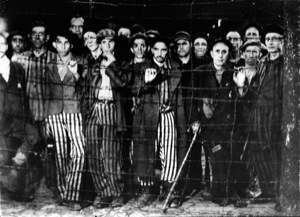
Getty Images
Margaret Bourke-White, Buchenwald concentration camp, Germany, 28 April 1945.
The figure of the person stripped of rights- the refugee, the victim of war, persecution and famine- would become the point of focus for concerned photographers and extensive image banks began to grow around these subjects. Children have been a central subject of focus: David 'Chim' Seymour's UNICEF-commissioned imagery of disoriented children across Europe in the wake of the Second World War, Eugene Smith's imagery of children deformed by mercury pollution in the Japanese fishing village of Minamata in the early 1970s and Raghu Rai's image of a child buried in the aftermath of the chemical gas leakage in Bhopol in 1984 all evidenced the suffering and confusion of innocents and implicitly indicted the powerful forces of the worlds to which they were subject.
Famine has provided what has come to seem staple imagery of human suffering, often entwined with war or civil conflict. Don McCullin's coverage of Biafra in the late 1960s was probably the first imagery of this type to widely impinge on Western consciousness and influenced thinking on humanitarian aid. Sebastiao Salgado's images of the famines of the Sahel also reached a wide audience, though they were so beautifully rendered that they provoked consternation about the ethics and aesthetics of depicting such suffering. James Nachtwey's images of famine victims in Somalia in 1992 also bring viewers uncomfortably close to the suffering of individuals.
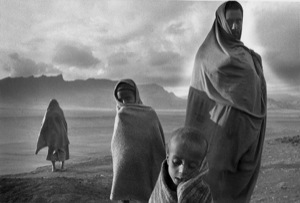
Sabastiao Salgado/Amazonas/nbpictures
Sahel region, Ethiopia.
Over the last 20 years, the significance of the role of the photographer as witness to abuse has been heightened in response to both geopolitical and technological conditions of globalization. One of the most significant geopolitical features of the ending of the Cold War has been the shift from a focus on national sovereignty to the rights of individuals. This has been accompanied by the explosive growth of international non-governmental organizations (NGOs) and driven the transnationalization of human rights claims and of the representation of these claims. Photojournalists have refigured their conventions in relation to these contexts and begun to work more directly and self-consciously within human rights frameworks, with NGOs often commissioning photographers. The ethical imperatives to bear witness and evoke compassion have become more assertively grounded and framed.
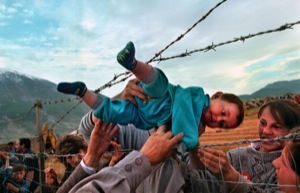
(c) 1999, The Washington Post. Photography by Carol Guzy. Reprinted with permission.
Kosovar refugee Agim Shala, 2, is passed through a fence into the hands of grandparents at a refugee camp in Kukes, Albania- 3 May, 1999.
Carol Guzy, in her work for The Washington Post, has developed a very intimate style of documenting the distress of refugees, especially women and children - notably in her essays on refugees from civil conflicts in Rwanda and Kosovo. James Nachtwey is one of the most famous exemplars of a humanitarian-focused photojournalism. He focuses resolutely on the individual, the subject of violation, often use close-ups in ways that unsettle viewers. Nachtwey embraces the role of witness and overtly addresses human rights issues: "My job is to reach a broad base of people who translate there feelings into an articulate stance, then through the mechanisms of political and humanitarian organizations, bring pressure to bear on the process of change." (Nachtwey)
Gilles Peress also works with a strong sense of moral responsibility and has pressed the boundaries of photojournalism further than most in efforts to challenge and stretch our comprehension of human violence and suffering, and to provide forms of documentation that can support legal testimony on war crimes and acts of genocide. His formal experimentation reflects these concerns, notably in images of the aftermath of mass killings in Rwanda and of the disinterment of bodies from mass graves in the former Yugoslavia. Peress states: "I work much more like a forensic photographer in a certain way, collecting evidence...I don't care that much any more about 'good photography'. I'm gathering evidence for history, so that we remember." (US News, 6 October 1997)
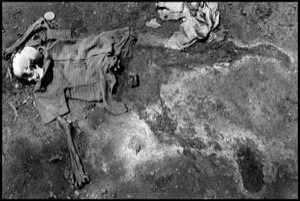
Gilles Peress/Magnum
Clothing and bleached bones were all that remained of this refugee, slain with over 1000 others at the parish church of Nyarubuye, Rwanda. Their bodies were not found until 44 days after the killings.
The proliferation and convergence of new media technologies - satellite, the Internet, digital image production - has greatly expanded the mediasphere in which imagery of human rights issues circulates, and also expanded the global capacities for visually documenting abuses and violations. With citizen journalists playing an increasingly significant part in such visual documentation, there are now many initiatives to capture and use this capacity. An example is the Witness Video Hub, which encourages people to record human rights abuses that they witness on their mobile phones and submit video for curation and online publication. There is also the growing use of satellite imagery in the advancement of human rights claims.
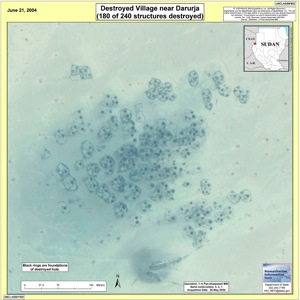
Digital Globe Inc., and Department of State via USAID
Satellite image of destroyed village near Darurja in the Darfur region of Sudan.
There are competing views on the effects of this increased flow of images and information about human rights matters. The more optimistic tend to argue that visual technologies have globalised human conscience, expanding our understanding of the human and of claims of the vulnerability of others. The pessimists point to continuing inequalities in media production and distribution and the ongoing management of information about international conflict and human rights claims within established governmental and media formations. The more cynical question political and public wills to translate emotional responses into directed social action, and refer to a growing consumption of suffering and an accompanying ‘compassion fatigue’.
At the heart of these differing perspectives is the issue of the ethical function of the image as a mode of evidentiary representation that bears witness to the suffering and degradation of others. It remains an important if contested function in the context of the expanding discourses and representations of human rights claims in our time.
Click here for ‘Photography & Human Rights’ Bibliography section.
Click here for ‘Photography & Human Rights’ Links section.


